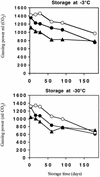Isolation and characterization of a freeze-tolerant diploid derivative of an industrial baker's yeast strain and its use in frozen doughs
- PMID: 12324320
- PMCID: PMC126419
- DOI: 10.1128/AEM.68.10.4780-4787.2002
Isolation and characterization of a freeze-tolerant diploid derivative of an industrial baker's yeast strain and its use in frozen doughs
Abstract
The routine production and storage of frozen doughs are still problematic. Although commercial baker's yeast is highly resistant to environmental stress conditions, it rapidly loses stress resistance during dough preparation due to the initiation of fermentation. As a result, the yeast loses gassing power significantly during storage of frozen doughs. We obtained freeze-tolerant mutants of polyploid industrial strains following screening for survival in doughs prepared with UV-mutagenized yeast and subjected to 200 freeze-thaw cycles. Two strains in the S47 background with a normal growth rate and the best freeze tolerance under laboratory conditions were selected for production in a 20-liter pilot fermentor. Before frozen storage, the AT25 mutant produced on the 20-liter pilot scale had a 10% higher gassing power capacity than the S47 strain, while the opposite was observed for cells produced under laboratory conditions. AT25 also retained more freeze tolerance during the initiation of fermentation in liquid cultures and more gassing power during storage of frozen doughs. Other industrially important properties (yield, growth rate, nitrogen assimilation, and phosphorus content) were very similar. AT25 had only half of the DNA content of S47, and its cell size was much smaller. Several diploid segregants of S47 had freeze tolerances similar to that of AT25 but inferior performance for other properties, while an AT25-derived tetraploid, TAT25, showed only slightly improved freeze tolerance compared to S47. When AT25 was cultured in a 20,000-liter fermentor under industrial conditions, it retained its superior performance and thus appears to be promising for use in frozen dough production. Our results also show that a diploid strain can perform at least as well as a tetraploid strain for commercial baker's yeast production and usage.
Figures







References
-
- American Society of Brewing Chemists. 1987. Methods of analysis of the American Society of Brewing Chemists. American Society of Brewing Chemists, St. Paul, Minn.
-
- Attfield, P. V. 1997. Stress tolerance: the key to effective strains of industrial baker's yeast. Nat. Biotechnol. 15:1351-1357. - PubMed
-
- Brin, M. 1966. Transketolase clinical aspects. Methods Enzymol. 9:506-514.
-
- Burrows, S., and J. S. Harrison. 1959. Routine method for determination of the activity of baker's yeast. J. Inst. Brew. 65:39-45.
-
- Clément, P., and A. Loïez. August1983. Strains of yeast for bread-making and novel strains of yeast thus prepared. U.S. patent 4,396,632.
Publication types
MeSH terms
LinkOut - more resources
Full Text Sources
Other Literature Sources
Molecular Biology Databases
Research Materials

